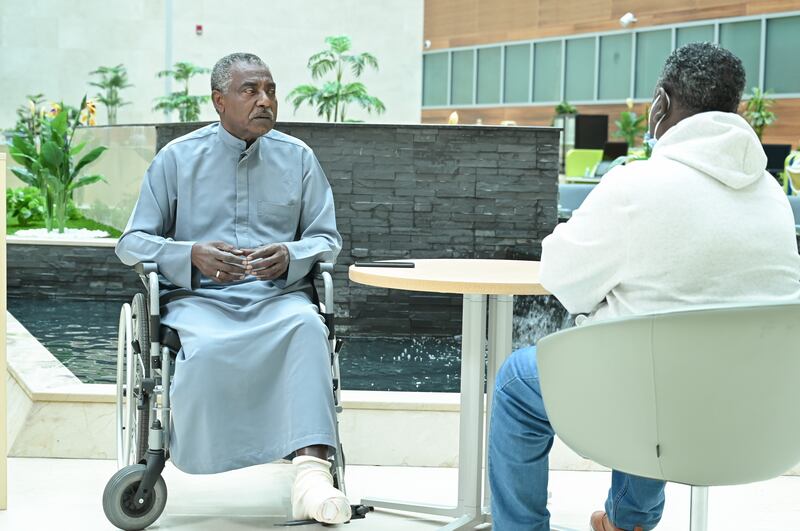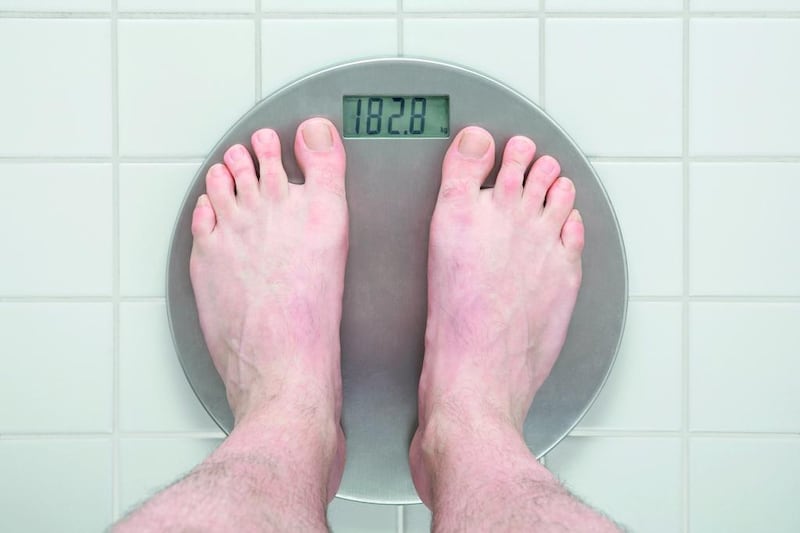Doctors in Abu Dhabi have saved a man's left leg after he lost the right one a year ago to unmanaged diabetes.
Medics at Sheikh Shakhbout Medical City said when Hassan Ahmed, 58, came to see them, his blood sugar levels were above 500 mg/dL (milligrams per decilitre) at times — 2.5 times the normal range of less than 200 mg/dL.
The toes on his left foot had turned black, and his eyesight had started to dwindle.
Mr Ahmed was at risk of losing his second leg, but doctors took a decision to operate immediately and used his own vein to bypass the area of blockage that carries blood to the foot and toes.
“He was in a terrible state when he arrived at the hospital. Two of the three main arteries in his leg were blocked,” said Dr Mohamed Baguneid, consultant and vascular and endovascular surgeon at Sheikh Shakhbout Medical City.
“The surgery we did on his left leg was from his groin to below the knee using his own vein in his leg.
“We did an angiogram at the same time to check all his blood vessels below the knee were fine and to check our bypass to make sure it was working well.
“He was frightened at first and imagined the same problem would happen again. We had to convince him and reassure him that things would be done differently this time.”

Dr Baguneid said some people with high blood sugar suffer from peripheral artery disease, a condition that causes the narrowing of the arteries delivering blood to the limbs, which, if left untreated, may lead to amputation.
He said using a patient's own vein to replace or bypass the blocked part of an artery is much better than using an artificial graft made of plastic.
He said in the previous surgery, when Mr Ahmed lost his limb, doctors at another hospital used an artificial graft.
“Artificial grafts don’t work as well as vein grafts and are only used when no vein is available,” Dr Baguneid said. “Doing a vein bypass takes longer and is technically more challenging, but it gives good results.”
Doctors at Sheikh Shakhbout Medical City had to remove Mr Ahmed’s toes in the left foot because of gangrene, but he can still manage to walk.
Another challenge for the doctors was to save his eyesight.
“He was going blind in both eyes very rapidly, but once he had his graft, we quickly focused on his eyesight because a diabetic patient who can’t see his foot will never know if he develops an ulcer,” Dr Baguneid said.
Five ways to prevent diabetes — in pictures
Having the right leg amputated
The problems in his right leg started as an ulcer but progressed to severe pain and gangrene, which is the death of body tissue due to a lack of blood flow or a serious bacterial infection, leading to amputation.
A few months ago, he started to face the same problem with his other foot.
Mr Ahmed urged people to take care of their diet and lifestyle to avoid health problems like diabetes.
He said he was in his 30s when he first developed diabetes, and life has been difficult since he lost one leg.
Mr Ahmed, from Egypt, said he lives alone in a small apartment in Mussaffah, and the building does not have an lift. Taking the stairs to his apartment on the third floor is a battle, he said.
“With just one leg and that too in a lot of pain, I dragged myself on my buttocks to climb the stairs,” he told The National.
“Life was unbearable and becoming very difficult. I went to the hospital when I couldn’t cope with the pain, and my vision deteriorated. I didn’t even see the ulcer on my foot.
“My wife and daughter, 23, are in Egypt. I'm currently without a job but hope to find one soon.”
Why is amputation necessary sometimes?
According to Mayo Clinic, diabetes complications can include nerve damage and poor blood circulation. These problems can lead to skin ulcers on the feet that can get worse quickly.
“Most lower leg and foot removals begin with foot ulcers,” it says. “An ulcer that won't heal causes severe damage to tissues and bone. It may require surgical removal (amputation) of a toe, a foot or part of a leg. Some people with diabetes are at higher risk than others.”
How to tackle diabetes?
There are two types of diabetes — 1 and 2. In both types, blood sugar levels can get too high because the body does not produce insulin or fails to use it properly. Insulin is a hormone that regulates blood sugar.
Type 1 diabetes is the result of a genetic disorder that often shows up early in life, and type 2 depends on our lifestyle and develops over time.
Doctors said monitoring blood sugar, eating healthy food, staying active and keeping an optimal weight are central to managing the disease.



















